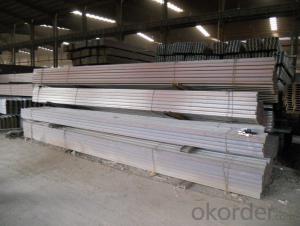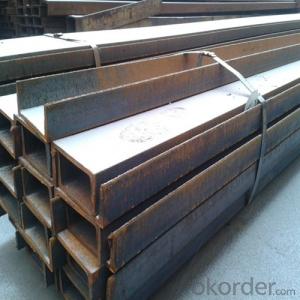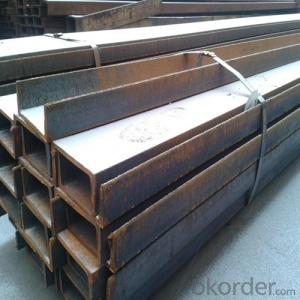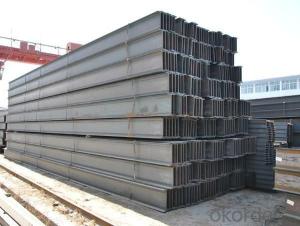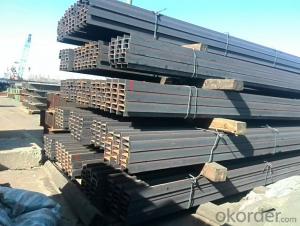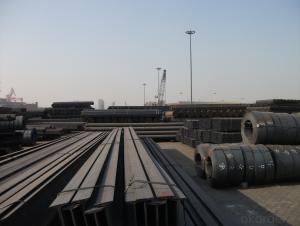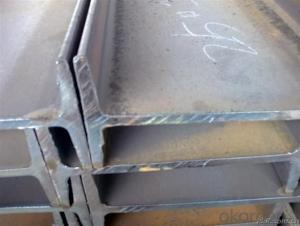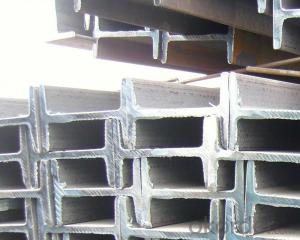GB Standard Hot Rolled Steel I Beams Q235, Q345
- Loading Port:
- Tianjin
- Payment Terms:
- TT OR LC
- Min Order Qty:
- 25 m.t.
- Supply Capability:
- 200000 m.t./month
OKorder Service Pledge
OKorder Financial Service
You Might Also Like
Specifications of GB Standard Hot Rolled Steel I Beams Q235, Q345
Standard: ASTM A36, EN10025, JIS, GB, etc.
Grade:S275, S355, SS400, Q235B, A36, Q345, etc
Sizes: 80MM-270MM
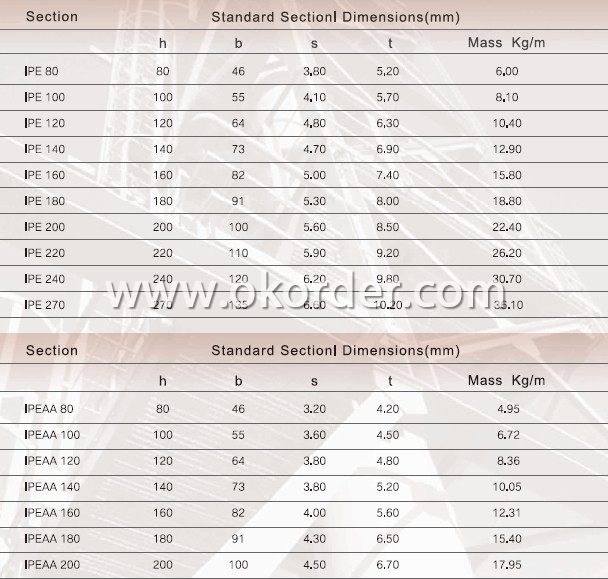
Applications of GB Standard Hot Rolled Steel I Beams Q235, Q345
Hot Rolled Steel I Beam is widely used in various building structures and engineering structures such as roof beams, bridges, transmission towers, hoisting machinery and transport machinery, ships, industrial furnaces, reaction tower, container frame and warehouse etc.
Package & Delivery Terms of GB Standard Hot Rolled Steel I Beams Q235, Q345
1. Package: All the hot rolled steel I beam will be tired by wire rod in bundles
2. Bundle weight: not more than 3.5MT for bulk vessel; less than 3 MT for container load
3. Marks:
Color marking: There will be color marking on both end of the bundle for the cargo delivered by bulk vessel. That makes it easily to distinguish at the destination port.
Tag mark: there will be tag mark tied up on the bundles. The information usually including supplier logo and name, product name, made in China, shipping marks and other information request by the customer.
If loading by container the marking is not needed, but we will prepare it as customer request.
4. Transportation: the goods are delivered by truck from mill to loading port, the maximum quantity can be loaded is around 40MTs by each truck. If the order quantity cannot reach the full truck loaded, the transportation cost per ton will be little higher than full load.
5. Shipment: In containers or in bulk cargo

6. Delivery time: All the hot rolled steel I Beam will be at the port of the shipment within 45 days after receiving the L/C at sight ot the advance pyment by T/T
7. Payment: L/C at sight; 30% advance payment before production, 70% before shipment by T/T, etc.
Production flow of GB Standard Hot Rolled Steel I Beams Q235, Q345
Material prepare (billet) —heat up—rough rolling—precision rolling—cooling—packing—storage and transportation
- Q: How do steel I-beams handle vibrations from nearby industrial operations?
- Steel I-beams are renowned for their exceptional structural integrity and ability to withstand various types of vibrations. When it comes to vibrations caused by nearby industrial activities, steel I-beams are highly efficient in dampening and dispersing these vibrations. The design of I-beams plays a crucial role in their ability to handle vibrations. The "I" shape provides unparalleled strength and stiffness, enabling the beams to resist bending and undesired deflections resulting from vibrations. The vertical flanges and horizontal web work in tandem to distribute and transfer vibrations throughout the entire length of the beam, minimizing concentrated stress. Moreover, steel I-beams possess inherent damping properties that aid in absorbing and dissipating vibrations. The material's high density and stiffness effectively convert vibrational energy into heat, reducing the amplitude and frequency of vibrations. This damping effect ensures that vibrations do not cause excessive movement or resonance within the structure. Additionally, steel I-beams can be further optimized to handle vibrations by incorporating various techniques. These techniques include the utilization of tuned mass dampers, which are additional masses strategically attached to the beams to counteract specific vibration frequencies. This technique significantly reduces vibration amplitude and minimizes their impact on the structure. Furthermore, steel I-beams can be designed to possess a higher natural frequency, which helps avoid resonance with frequencies generated by nearby industrial operations. By adjusting the size and shape of the I-beam, engineers can ensure that the beam's natural frequency is significantly different from the frequencies produced by nearby operations, preventing resonance and potential damage. Overall, steel I-beams are exceedingly effective in handling vibrations resulting from nearby industrial activities. Their inherent properties, such as exceptional strength, stiffness, and damping capabilities, combined with additional techniques like tuned mass dampers and natural frequency adjustments, make them an ideal choice for structures requiring the ability to withstand and mitigate vibrations.
- Q: Can steel I-beams be used for airport hangar construction?
- Airport hangars can indeed be constructed using steel I-beams. These I-beams are widely used in construction because of their robustness and durability. They offer structural support and can withstand substantial weights, making them ideal for constructing large span buildings like airport hangars. Moreover, steel I-beams can be effortlessly manufactured and tailored to meet the precise design specifications of an airport hangar. They also possess fire and corrosion resistance, which are crucial factors to consider in hangar construction. Hence, due to their dependability and aptitude to meet the distinctive requirements of such structures, steel I-beams are a favored choice for constructing airport hangars.
- Q: How is a steel I-beam different from other types of beams?
- A steel I-beam is different from other types of beams due to its distinctive shape, which resembles the letter "I". This design provides the I-beam with superior strength and load-bearing capabilities compared to other beam types. The flanges (horizontal sections) of the I-beam provide resistance against bending, while the web (vertical section) offers stability and support. The I-beam's unique construction makes it an ideal choice for structural applications where strength and durability are crucial.
- Q: What are the different types of steel finishes available for steel I-beams?
- There are several different types of steel finishes available for steel I-beams, each offering unique benefits and aesthetics. The most common types of steel finishes for I-beams include: 1. Mill finish: This is the standard finish as it comes from the mill, with a rough, raw surface. It is typically gray in color and is suitable for applications where appearance is not a priority. Mill finish is often used in structural applications where the steel will be covered or painted. 2. Hot-dip galvanized: This finish involves immersing the steel I-beam in a bath of molten zinc, creating a protective coating that prevents corrosion. Hot-dip galvanized steel I-beams are durable, long-lasting, and ideal for outdoor applications, as they can withstand harsh weather conditions and exposure to chemicals. 3. Powder coated: Powder coating involves applying a dry powder to the steel I-beam, which is then heated and cured to create a durable, smooth finish. Powder coated steel I-beams are available in a wide range of colors and provide excellent resistance to corrosion, abrasion, and chemicals. This finish is often used in architectural and decorative applications, where aesthetics are important. 4. Painted: Steel I-beams can also be painted with various types of paint, such as epoxy, enamel, or acrylic. Painting provides an additional layer of protection against corrosion and can enhance the appearance of the steel. Painted finishes are commonly used in indoor applications, such as commercial buildings or residential structures. 5. Stainless steel: Stainless steel I-beams offer a unique finish that is resistant to corrosion, staining, and rust. This type of steel finish is commonly used in environments where hygiene and cleanliness are crucial, such as food processing plants, hospitals, or pharmaceutical facilities. It is important to consider the specific requirements of your project, such as the intended use, environment, and aesthetic preferences, when choosing the appropriate steel finish for I-beams. Consulting with a steel supplier or engineer can help ensure the right finish is selected for your application.
- Q: What specifications are used for the steel structure of the 10*10? Do I have to use I-beam? Will the iron square be all right?
- Square tube can be, but it is better to buy GB material, otherwise the wall thickness is too thin, can not meet the design requirements ~!
- Q: Can steel I-beams be used for parking structures?
- Yes, steel I-beams can be used for parking structures. Steel I-beams are strong and durable, making them suitable for supporting the weight of vehicles and providing a stable structure for parking facilities.
- Q: What is the cost of steel I-beams compared to other structural materials?
- The price of steel I-beams can vary depending on several factors when compared to other structural materials. Generally, steel I-beams are more expensive than materials like wood or concrete. However, when compared to other steel structural materials, such as steel tubes or columns, I-beams may be more cost-effective. Various factors influence the price of steel I-beams, including the size and weight of the beam, the grade of steel used, and market conditions. Larger and heavier I-beams will generally have a higher cost because they require more raw materials and production processes. The grade of steel used can also affect the price, with higher-grade steels typically costing more due to their enhanced strength and durability. Market conditions also play a significant role in determining the cost of steel I-beams. Changes in the availability and demand for steel can impact the price. For example, during periods of high demand or shortages, the cost of steel I-beams may increase. Conversely, during periods of low demand or oversupply, prices may be more competitive. It is important to note that while steel I-beams may have a higher upfront cost compared to other materials, they offer numerous advantages that make them a preferred choice for many construction projects. Steel I-beams are known for their exceptional strength-to-weight ratio, durability, and versatility. They can withstand heavy loads, provide long-term structural integrity, and require minimal maintenance. These benefits often outweigh the initial cost and make steel I-beams a cost-effective choice in the long run. Ultimately, the cost of steel I-beams compared to other structural materials will depend on various factors, including size, grade, market conditions, and the specific needs of the project. It is advisable to consult with a construction professional or supplier to obtain accurate and up-to-date pricing information for a specific application.
- Q: Can steel I-beams be used in interior design or decorative applications?
- Yes, steel I-beams can be used in interior design or decorative applications. They are often utilized to create a modern and industrial look in residential and commercial spaces. The clean lines and structural strength of steel I-beams can add a unique and contemporary aesthetic to various interior design elements such as exposed ceilings, staircase supports, mezzanines, room dividers, and shelving systems.
- Q: Are steel I-beams environmentally friendly?
- Steel I-beams, while not inherently environmentally friendly due to the significant amount of energy required for their production, can be considered environmentally friendly when considering their long lifespan and recyclability. Steel is a highly durable material that can last for decades without degradation, reducing the need for frequent replacements. Additionally, steel is one of the most recycled materials globally, with a high recycling rate, which helps to reduce the demand for virgin steel production and conserve resources. Therefore, when considering their life cycle and potential for recycling, steel I-beams can be considered a relatively environmentally friendly option for construction.
- Q: What is the difference between I-beam and H steel?
- The key difference is that the inside of the wing plate of the I-beam has a slope rather than an equal thickness, which is adapted to the traveling wheel of the suspension crane.
Send your message to us
GB Standard Hot Rolled Steel I Beams Q235, Q345
- Loading Port:
- Tianjin
- Payment Terms:
- TT OR LC
- Min Order Qty:
- 25 m.t.
- Supply Capability:
- 200000 m.t./month
OKorder Service Pledge
OKorder Financial Service
Similar products
Hot products
Hot Searches
Related keywords
